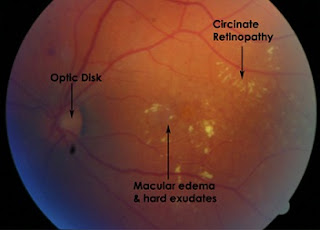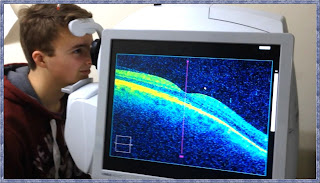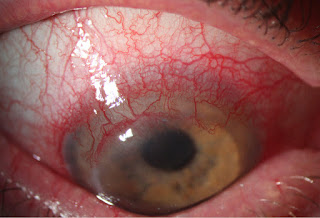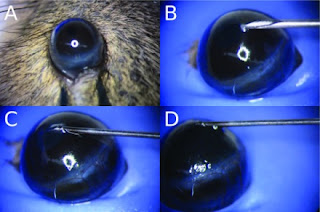Calotropis
procera is a flowering plant native to North Africa, South Asia and Indonesia.
The flowers produce bitter and sticky toxic milk. It possesses both inflammatory and anti-inflammatory pharmacological properties. Topic
application of latex from C. procera I affects eye with diffuse corneal edema.
It resulted in reduced endothelial cell count and severe ocular injuries and a
loss of endothelial cells over a period of time. Public education, early
recognition of such injuries, and timely intervention may prevent permanent
ocular damage.
Wednesday 31 May 2017
Tuesday 30 May 2017
Ocular Biometry in Patients with Primary Open Angle Glaucoma (POAG)
Glaucoma is the leading cause of
blindness all over the world after cataract blindness. In 2010, worldwide 60.5
million people were expected to have OAG (Open angle glaucoma) and ACG (Angle
closure glaucoma), increasing to 79.6 million by 2020, and of these, 74% will have OAG1. Asians represent 47% of those with all glaucoma and 87% of those
with ACG1. 4.5 million People with OAG and 3.9 million people with ACG were
expected to have bilateral blindness in 2010, rising to 5.9 and 5.3 million
people in 2020, respectively.
There are approximately 11.2
million persons aged 40 years and older with glaucoma in India. Primary open angle glaucoma is estimated to affect 6.48 million persons. The estimated number with
primary angle-closure glaucoma is 2.54 million. Those with any form of primary
angle-closure disease could comprise 27.6 million persons.
Monday 29 May 2017
Mascara: A Cause of Thermal Burn after Cautery for Eye Lid Lesion Excision; A Case Report
Surgical
fires are rare in ophthalmic surgery. Occurrence poses disastrous risks on the
eye and the patient. Mascara can play a role in the occurrence of flash fires
in the vicinity of surgical fields by acting as a fuel source. We report a case of thermal burn of eye lashes, eyelid skin and eye brow hair in a patient who was wearing mascara while cautery was applied to her eyelid lesion after excision. Mascara had caused a spark fire when applying cautery
after eyelid lesion excision in a young patient. Conclusion: Surgeons as well
as the entire ophthalmic care team should be aware of this incident to try to
minimize the risk of thermal injury by working in a make-up free ophthalmic
field.
Thursday 25 May 2017
Sports-Related Concussion: The Eyes Have It
Concussion is a form of mild
traumatic brain injury (TBI) owing to structural, metabolic and functional changes involving white mater tracts of the central nervous system in the absence of macroscopic findings. Sports-related concussion is a rapidly evolving
condition stimulating interest among lay and scientific communities.
Recent
studies have shown a high rate of under reporting of concussion signs and
symptoms by athletes and side line personnel. Accordingly, reliable and validated testing strategies are necessary to insure timely detection and removal from play for individuals suspected of concussion. Vision and visual
motor problems are commonly reported among athletes following concussion. This
is to be expected as it is estimated that approximately 50% of the brain is
devoted to vision and visual motor processing. As such, testing of vision and
ocular motility function are critical to the evaluation of a concussed
individual.
Wednesday 24 May 2017
Novasorb Cationic Nanoemulsion and Latanoprost: the Ideal Combination for Glaucoma Management?
Novasorb is a patented eye drop
formulation platform developed to optimise the interaction of the eye drop-the
cationic nanoemulsion-with the different layers of the tear film, mainly with the tear film lipid layer (TFLL), and the ocular surface.
The composition of
the cationic nanoemulsion was designed to mimic the attributes and functions of
the tear film and TFLL, and take advantage of the negatively-charged mucin
layer covering the corneal and conjunctival epithelium, to increase its
spreading and residence time on the ocular surface. Consequently, Novasorb®-based artificial tears (AT, e.g. Cationorm®) are functionally and mechanically very close to a healthy tear film; with an iso-osmolar to slightly
hypo-osmolar aqueous phase, polar (cetalkonium chloride, CKC) and nonpolar
(mineral oils or medium chain triglycerides, MCT) lipids, and surfactants (e.g.
Tyloxapol and Poloxamer) that mimic the surface active proteins present at the
interface with the TFLL.
Monday 22 May 2017
Corneal Toxicity after Self-Application of Calotropis procera (Ushaar) Latex: Case Report and Analysis of the Active Components
Calotropis
procera (ushaar) produces a copious amount of latex, which has both
inflammatory and antiinflammatory pharmacological properties. Local application
produces an intense inflammatory response and causes significant ocular
morbidity.
We report corneal toxicity following self-application of latex from
C. procera in a 74-yearold man. He reported painless decreased vision in the affected eye with diffuse corneal edema, and specular microscopy revealed a reduced endothelial cell count. After he was treated with topical
corticosteroids, his visual acuity improved from HM to 20/80. The composition
of the active compounds in the latex was analyzed. When topically administered,
the latex may cause severe ocular injuries and a loss of endothelial cells over
a period of time. Public education, early recognition of such injuries, and
timely intervention may prevent permanent ocular damage
Friday 19 May 2017
Cornelia de Lange Syndrome with Congenital Glaucoma
Cornelia De Lange syndrome (CDLS),
also known as Brachmann de Lange syndrome is a rare syndrome. It ischaracterised by distinctive facial dysmorphism, growth retardation,developmental delay, upper limb reduction defects, gastroesophageal dysfunction, ophthalmologic and genitourinary anomalies, hirsutism, pyloric
stenosis, congenital diaphragmatic hernias, cardiac septal defects, and hearing
loss. The syndrome was first described by a Dutch paediatrician named Cornelia
de Lange, in 1933.
Though the genetic basis of this
syndrome is not clear, a majority of cases are due to spontaneous mutations.
The defective gene can be inherited from either parent, making it autosomal dominant
type of inheritance.
Synophrys, long curled lashes,
myopia, and hypertrichosis of the brows. These patients have also been found to have ptosis, epiphora, nasolacrimal duct obstruction, and micro cornea, congenital
glaucoma, corneal opacities, iris heterochromia and optic nerve head
pallor/atrophy.
Thursday 18 May 2017
Maculopathy associated with Prior Tamoxifen Use Diagnosed with Commercially Available Fourier-Domain Optical Coherence Tomography: A Case Series
Tamoxifen is a drug used to treat
estrogen receptor positive breast cancer that can induce retinopathy. The diagnosis of tamoxifen retinopathy is traditionally established by macularedema seen on fluorescein angiography and retinal crystalline deposits seen on funduscopy. Macular edema associated with tamoxifen retinopathy has been
reported to be reversible after cessation of the drug but the retinal crystalline
opacities usually persist.
Recently, a case of bilateral microcystoid
maculopathy with patches of photoreceptor loss associated with concurrent
tamoxifen use was detected using a research-grade high resolution
Fourier-domain optical coherence tomography (Fd-OCT) in a patient with vision
loss unexplained by funduscopy, fluorescein angiogram (FA), multifocal electro retinography and Stratus OCT. This report describes two new cases of maculopathy associated
with prior tamoxifen use in which similar morphologic changes were seen using
commercially available Fd-OCTs, Cirrus (Carl Zeiss Meditec, Dublin, CA) and
RTVue (Optovue, Fremont, CA), in eyes that appeared unremarkable on funduscopy.
Tuesday 16 May 2017
Anterior Vitreous Incarceration after Phacoemulsification Cataract Extraction Imaged with Spectral-Domain Optical Coherence Tomography
Anterior vitreous incarceration is
a condition in which vitreous prolapses into the anterior chamber and passes
through a microscopic wound at an incisional site. The condition can be identified as a vitreous strand leading to the wound site during slit lamp examination. If the vitreous strand penetrates through all the corneal layers
on to the extra ocular surface it becomes vitreous wick syndrome. Anterior
segment imaging with spectral-domain optical coherence tomography of the
iridocorneal angle can provide high definition scans to confirm vitreous
incarceration and rule out vitreous wicking. It is important to appropriately
diagnose this condition to prevent vision threatening complications.
Monday 15 May 2017
General on Glaucoma and Oxidative Stress. Comments on Study Design: “Biomarkers of Lipid Peroxidation in the Aqueous Humor of Primary Open angle Glaucoma Patients”
Glaucoma is an optic neuropathy
that causes progressive changes in the visual field and whose main known risk
factor is the increased IOP. Primary open-angle glaucoma (POAG) is associated with asymptomatic and irreversible vision loss, although its cause is unknown,
it is known that in the presence of elevated intraocular pressure (IOP) occurs
sequentially death of retinal ganglion cells by apoptosis and optic nerve
fibres in its evolution cause glaucomatous optic atrophy and permanent loss of
vision. There has never been unanimously to establish which of the two
injuries, structural or functional, it can first be detected. However, experts
generally agree that early diagnosis is critical to improving the prognosis of
glaucomatous patient.
Thursday 11 May 2017
Management of Corneal Graft Rejection - A Case Series Report and Review of the Literature
To report long-term results in a
case series of patients treated with systemic immune suppression for prevention
of penetrating keratoplasty (PKP) graft rejection. Retrospective non comparative
chart review. Three patients presented with PKP graft failure.
Patients received oral prednisone, azathioprine and cyclosporine to
prevent rejection of repeat corneal transplant. Patients received repeat PKPand graft outcome was reported. Main outcome measures: Visual acuity and graft
survival were recorded. Mean age was 55 years, two male and one
female. Mean follow-up period was 37 months (range 24- 46). All three patients
completed the treatment protocol with minimal adverse effects. All grafts
remained clear over observational period. Conclusion: Our study suggests that
systemic immune suppression with 2 or more agents may be helpful to prevent
corneal graft rejection in high-risk patients.
Wednesday 10 May 2017
Vision-related Quality of Life in Children with Amblyopia
Vision plays an important role in
most everyday activities. Consistent with this, people with visual impairment
are usually faced with significant challenges in their daily activities. In children, such activities include playing, reading, socialisation and taking care of their daily needs. In the paediatric ophthalmological field, visual
problems include high refractive errors, binocular disorders, depth perception
deficiency, amblyopia and ocular pathology. These visual impairments in
children potentially cause psychological and functional changes and could
affect educational and social prospects and may thus impact on vision-related
quality of life (VRQoL).
Amblyopia is usually defined as a
unilateral or bilateral reduction in visual function caused by abnormal visual
input resulting from degradation of the retinal image during a sensitive period
of visual development, which historically has been thought to be the first
seven years of life.
Tuesday 9 May 2017
Ologen versus Mitomycin-C for Trabeculectomy in a Predominantly African American PopulationOlogen versus Mitomycin-C for Trabeculectomy in a Predominantly African American Population
Glaucoma is the most common cause
of irreversible blindness worldwide. Treatment of glaucoma begins with medical
management but often requires surgical intervention. Since the late 1960s, the most common surgical treatment for glaucoma has been trabeculectomy. AGIS
investigators and others have established that race plays a significant role in
an individual’s response to trabeculectomy. Specifically, African American
patients have been shown to have advanced glaucoma at time of diagnosis and
respond less favorably than Caucasian patients to trabeculectomy. Our group
wishes to investigate the role of ethnicity in specific surgical treatments for
glaucoma.
Monday 8 May 2017
Different Modalities of Antifungal Agents in the Treatment of Fungal Keratitis: A Retrospective Study
The study reviewed 251 eyes of 246
patients treated for moderate and severe fungal keratitis in the period from
2010 to 2015. The diagnosis of fungal keratitis based on the clinical characteristics features of fungal keratitis beside laboratory diagnosis. The anti fungal drugs were determined according to the commercial availability at
the time depending on the clinical features, also to some extent to the
laboratory diagnosis. Ten different modalities of anti fungal agents beside
antibacterial agents and cycloplegic drugs were used.
Thursday 4 May 2017
Primary Open Angle Glaucoma Poses Threats in the Form of Increased Axial Length
Primary Open Angle Glaucoma (POAG)
is one of the most common forms of eye disease that occurs due to high
Intraocular Pressure (IOP). If untreated, it would leads to periphery loss of vision that gradually leads to complete blindness.. When a comparative study was
initiated to determine the axial length (AL) and K value between two groups of
patients consisting patients with POAG and the age matched controls group,
Patients with POAG are having longer AL and flatter corneas than the
age-matched controls. This would clearly highlights the risks involved for the
patients of POAG.
Wednesday 3 May 2017
Un-doing All that Good Work! Glaucoma after Vitrectomy and Silicone Oil Injection for the Treatment of Complicated Retinal Detachment
A fifty-two year old bilaterally
pseudophakic Caucasian gentleman having a retinal detachment secondary to two
retinal breaks superotemporally in his right eye underwent twenty-three gauge
pars plana vitrectomy (PPV), endophotocoagulation and perfluoroethane (C2F6)
gas insertion. He presented five weeks later with a total retinal detachment in the same eye presumed consequent to a retinal break infero temporally thought to represent temporal extension of the initial retinal tear beyond the margin of the aforementioned retinopexy. Twenty gauge PPV was performed, cryotherapy was
applied to the retinal break, indirect retinal photocoagulation carried out and
16% perfluoropropane (C3F8) inserted into the vitreous cavity.
Subscribe to:
Posts (Atom)














